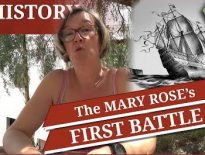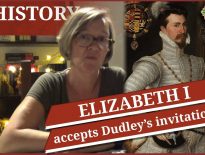On this day in Tudor history, 9th August 1588, Queen Elizabeth I gave her famous Tilbury Speech to the forces gathered at Tilbury Fort.
It is a speech that has been immortalised on screen by the likes of Glenda Jackson and Cate Blanchett, and is famous for the line "I know I have the body but of a weak and feeble woman; but I have the heart and stomach of a king, and of a king of England too", but what words did Elizabeth really speak that day?
In today's talk,I share three versions of Elizabeth I's Tilbury Speech.
Also on this day in history:
- 1556 – Funeral of Sir William Laxton, Lord Mayor of London (1544-5) and one of the wealthiest London merchants, at the parish church in St Mary Aldermary. The funeral was followed by a banquet hosted by the Grocers' Company of London and a mass led by John Harpsfield, Archdeacon of London.
- 1557 – Burial of the composer Nicholas Ludford in St Margaret's Church, Westminster. Ludford is known for his festal masses, which can be found in the Caius and Lambeth choirbooks (1521-27) and the Peterhouse partbooks (1539-40), and has been described as “"one of the last unsung geniuses of Tudor polyphony" (David Skinner).
- 1561 - While on a visit to Ipswich in Suffolk, Queen Elizabeth I issued injunctions forbidding women to reside in cathedrals and colleges.
- 1611 – Death of John Blagrave, mathematician and land surveyor. He was buried in St Lawrence's Church, Reading. Blagrave's works included “The Mathematical Jewel” (1585), Astrolabium Uranicum generale (1596) and “The Art of Dyalling” (1609). He also designed and made instruments, including sundials and astrolabes.



She probably did have some kind of breast plate and a white horse, as she was being very iconic but she certainly didn’t look as she did in Elizabeth The Golden Age, as her hair was most likely white or grey/silver with age. However, she was probably still quite magnificent as monarchs always were. Elizabeth took great care to show herself as a fine and magnificent person, beautifully dressed and to make a wonderful image for those they came before. However, we also have to remember that she also showed herself in allegory and in mythical images. Her speeches may well be a make up of all of that. They could well be from different eye witnesses and the triumphant allegories added for effect. In the end it probably doesn’t matter because whatsoever she said, Elizabeth had a magical presence and awe inspiring countenance and must have truly looked wonderful and been a great inspiration to her troops on that day. It was obviously memorable.
The first one for me seems more realistic, although in reality the danger had passed or she wouldn’t have been there, she wouldn’t have been allowed there, but the Glenda Jackson version, the first one is more accurate I think. The others seem more like a sermon or to inspire the mythology of Elizabeth. Saatchi and Saatchi were doing a great job.